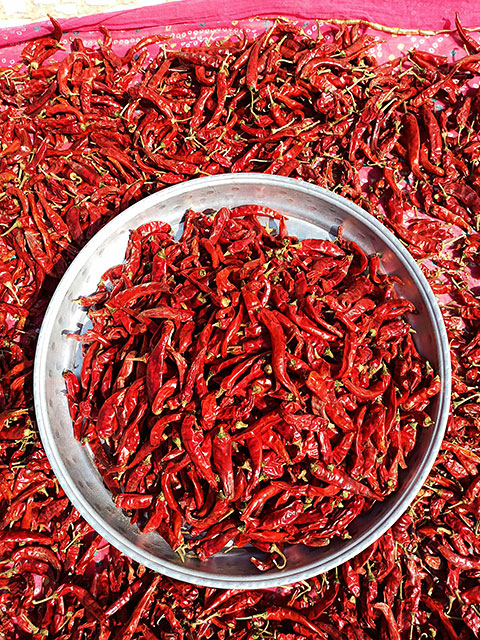Cuisine » Herbs And Spices
 Black Pepper
Black PepperBlack pepper has had many uses over the years, but its main use has been as a preservative, mostly as a whole peppercorn in rice, meat, game, and pickles. Powdered, it is one of the main ingredients of the mixed spices that are the basis of curry powders. Other uses have been for the alleviation of colds, coughs, and constipation.
Cardamom
First cultivated in India for its aromatic, culinary, and medicinal purposes, Cardamom has been used for flavoring such savory dishes as curries and some sweets. Other uses have been for stomach disorders, urine retention, and as a heart tonic.
Chili Peppers
These members of the genus Capsicum provide spicy hot flavor to foods. Peppers are rich in vitamin C and are very effective in clearing the sinuses.
Cinnamon
Cinnamon has had heavy use to season rice and lentil dishes, as well as fish. Medicinally it has been used for head and body aches, stiffness, bladder disorders, heart tonic, decongestant, coughs, colds, and sore throats.
Cloves
Cloves are dried, unopened flower buds. Their sharp, pungent bite and warm familiar aroma makes them an essential ingredient in certain spice blends (Garam Masala for instance).
Coriander
Coriander leaves (a.k.a. Cilantro) have been used for years as a seasoning. Chopped leaves are sprinkled over curried meats and vegetables. Its seeds are roasted and crushed to form the spices for almost all savory dishes. Ayurvedic uses include use as a diuretic, a fever breaker, and as a digestive aid.
Cumin
Cumin is one of the earliest spices cultivated by Indians for use in seasoning curries, pickles, or breads. Because of its effectiveness in expelling gas in the stomach, it has sometimes been used in the treatment of diarrhea and other discomforts of indigestion.
Curry Leaves
These small, oval-shaped leaves from the curry plant impart an aromatic curry-like flavor to dishes.
Cassia Lignea
With its light and distinctive flavor, this spice has been popular in flavoring rice, puddings, fish gravies, vegetable greens, and lentils. Ayurvedic medicinal purposes include treatment for dehydration, fever, anemia, body odor and coughs.
Drumsticks
The drumstick, which is rich in vitamins, particularly vitamin A, is popular in curries, lentil, and vegetable dishes. Drumsticks and medicines isolated from them have been used as a natural antibiotic, anti-fungal, andti-tubercular, and externally for leg spasms.
Fenugreek
Fenugreek greens are used as a vegetable (like spinach) when fresh and as a herb when dried. Seeds from the Fenugreek plant are also used as a spice.
Ginger
Ginger has been used heavily in preserves, chutneys, vegetable, and meat dishes. In Ayerveda it is regarded havily for use against colds, coughs, bronchitis, indigestion, diarrhea, nausea, breaking of fevers, headaches, respiratory infections, and as a stimulant.
Mahua
Mahua is sometimes cooked into a vegetable dish or made into puddings and sweetmeats, or ground into a meal. Medicinally, it is sometimes used as a treatment for respiratory ailments, diabetes, and externally for various skin ailments.
Mint
The highly aromatic, dark green, oval mint leaves play a cricial part in Indian cuisine. They are used extensively in chutneys and sauces.
Mustard
Of the three varieties (yellow, brown, and black), Indian cuisine uses brown mustard seeds. These tiny round seeds are dark brown to black on the outside and yellow on the inside. They have a sharp, pungent flavor which mellows after they are fried or roasted
Palmyra
Palmyra is most widely known for the sweet sap the tree produces. This sap is high in vitamins, and in Ayurveda has had many uses including the treatment of diarrhea and as a diuretic. Its sap forms into a thick molasses twice a year (which is then made into a sugar called jaggery), and the sap has also been used in such spirits as tadi (or "toddy") and arak.
Tamarind
Tamarind is rich in vitamin C, and is a popular ingredient in both curries and preserves. Medicinally it has been used to lower body temperature, and to fight mouth and throat infections.
Tumeric
Belonging to the same family as Ginger, Tumeric is also a rhizome (root). To obtain the familiar powder, the root is boiled, peeled, dried and then ground.